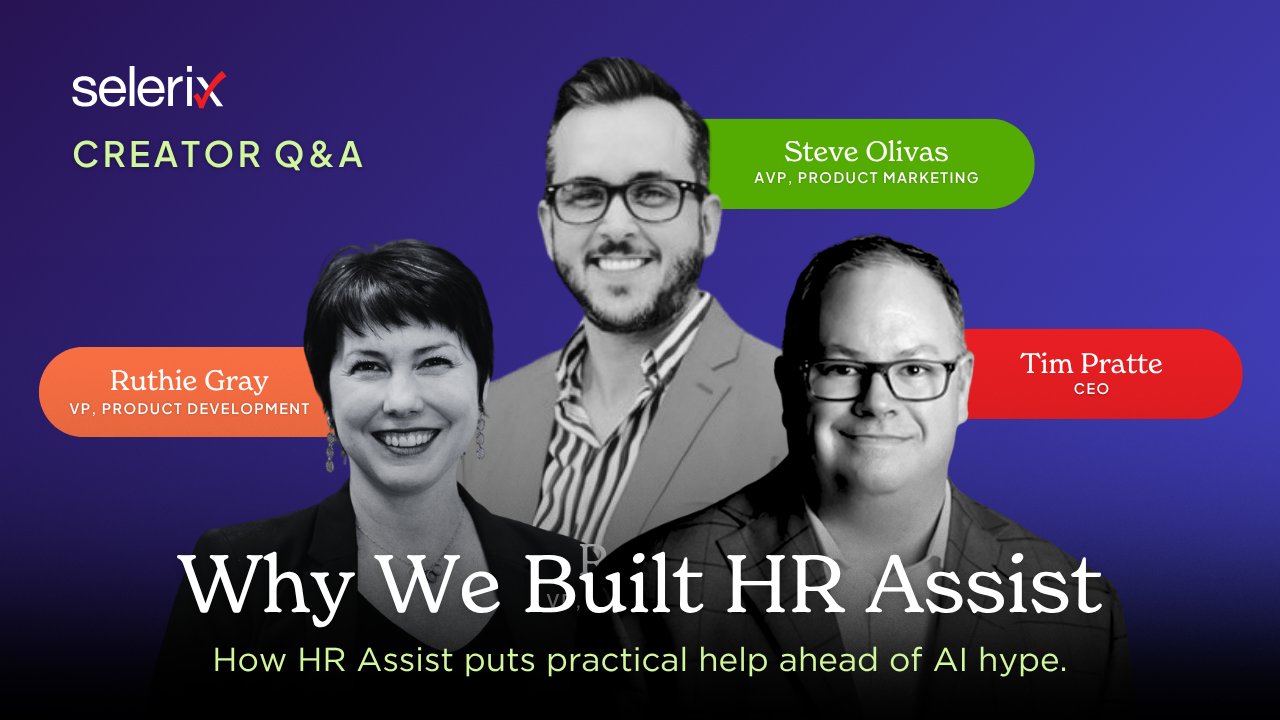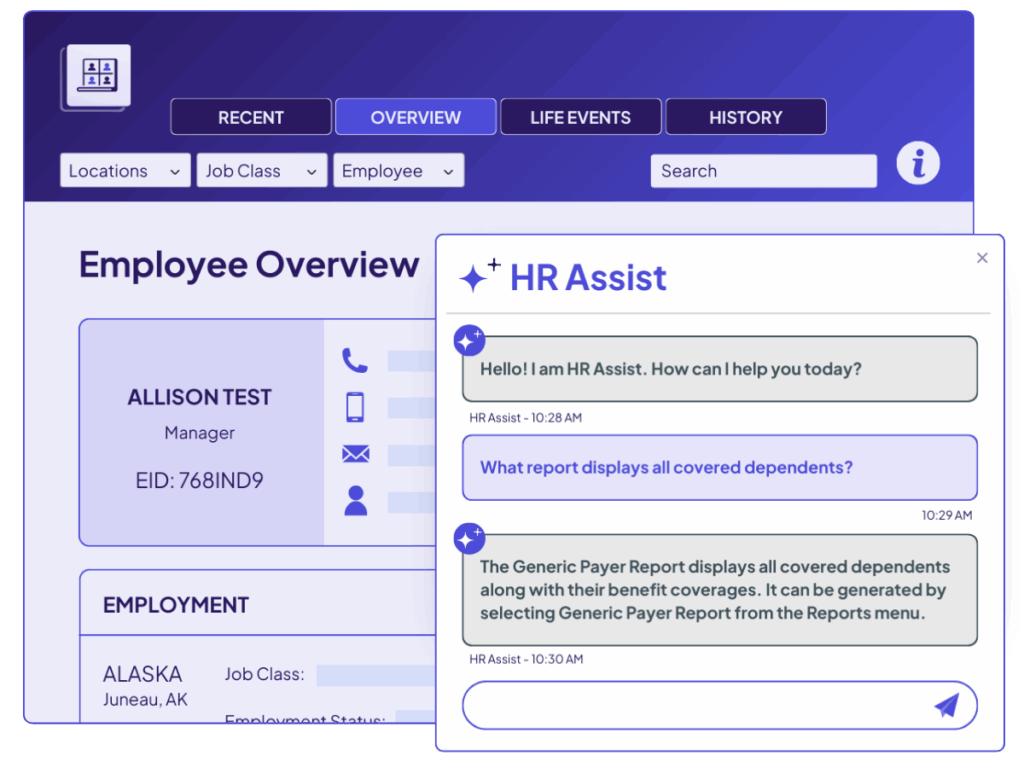Creator Q&A: Why We Built HR Assist — and Why It’s Different

Behind every successful open enrollment, onboarding, or eligibility update is a benefits admin juggling dozens of tasks — and answering loads of questions. So. Many. Questions.
“Even in the smoothest benefits programs, answering all the questions is a full-time job — and not one anyone wants.”
Built directly into BenSelect, HR Assist is a 24/7 AI-powered assistant designed to help admins get instant answers to everyday system questions. It’s trained on Selerix’s own support and training materials — not the open internet — and built to reflect the real workflows of real benefits teams.
Leaving AI hype behind, HR Assist was built with purpose: to save time, reduce repetitive questions, and make the admin experience faster, simpler, and more consistent for everyone, including brokers who support multiple clients.
To get the story behind the product, we sat down with two of the people who helped bring it to life: Selerix CEO Tim Pratte and VP of Product Development Ruthie Gray. Our own Steve Olivas, AVP of Product Marketing got them talking about why we built HR Assist the way we did, what makes it different, and what’s next.
Here’s how it went.

So, let’s start with the basics: What is HR Assist? How does it work, exactly?
Ruthie Gray (VP of Product Development):
HR Assist is a built-in AI assistant for BenSelect admins. You type a question in plain language — like “How do I process a life event?” — and it gives you a step-by-step answer, right inside the platform. It’s based on real documentation from our support and training teams, and it’s available 24/7. There’s no setup. No extra login. Just answers, right when you need them.
Tim Pratte (CEO):
You can think of it like having a senior admin on-call, who never sleeps or gets annoyed at you for asking the same question again.

This is Selerix’s first AI-based product. Why AI? Why this AI. Why now?
Tim:
I can tell you it wasn’t just to get into AI.
It was because agentic AI was the best answer to a need we saw. We kept hearing a lot of the same questions over and over from clients, from brokers. Like: “Where’s that report again?” or “Can you remind me how to do XYZ?”
The real problem was, the more experienced team members, or the brokers, were fielding these kinds of questions repeatedly and it was pulling them away from their own work. That’s not a good use of anyone’s time.
So we started thinking: what if we could move those questions to someone who could be that repository of team knowledge and help people with those questions without draining team bandwidth? And the obvious answer was AI.
Ruthie:
Yeah. We didn’t just wake up one day and decide to “do AI.” We’ve been watching this space evolve, and if I’m honest, a lot of what’s out there doesn’t work in our world. Many of the AI implementations in HR and benefits tech tends to lack depth, and don’t fully take into account how administrators work, so they don’t always add much value.
What we wanted to build was very specific: a tool that knows BenSelect, understands admin language, and gives task-level help that people can trust. For that, agentic AI is perfect.

What do you think makes HR Assist different from the other AI tools out there?
Tim:
We didn’t train it on the open internet. It’s not trying to guess. HR Assist is based entirely on Selerix materials. It’s secure. It’s continuously updated. We trained it on the same information our support teams use every day. So when someone asks a question, they get the exact right answer, always.
Ruthie:
The other big difference is that it’s focused. It’s not trying to be a co-pilot for your entire HR function. It’s helping with benefits administration, and that’s what it knows. We scoped it tightly by design. It gives you the help you need, when and where you need it, without any noise or hallucinations.

And you made the choice to start with admin users, not employees. Why?
Tim:
Benefits admins are doing a ton behind the scenes, and they’ve been underserved for a long time. A lot of our innovation has gone to the employee side, which is great because it makes the benefits experience awesome. But the administration is where the work really happens. We know there are usually a few folks holding all that together, doing more with less, and we wanted to give them a little breathing room.
Ruthie:
It also helps broker teams. Our support teams are always there, but it’s not unheard of, when a client has a question, that the broker gets looped in. And it’s usually not about benefits strategy. It’s: “Where do I click again?” HR Assist gives people a place to go for basic questions. They don’t have to feel dumb for asking them, and brokers can spend less time doing program support.

So far, how are people reacting?
Ruthie:
It’s been a strong start. People appreciate that it’s built in. There’s no extra login. No training. Just: ask a question, get an answer, keep moving. Even experienced users have told us it saves them time, they don’t have to second-guess or search through folders. It’s just easier. Even more importantly they tell us, they love their teams, but this saves them so much time in answering repetitive questions.
Tim:
One client told us, “I didn’t realize how much time I was losing until I stopped losing it.” That sums it up pretty well.

What’s next — for HR Assist and for AI at Selerix?
Tim:
HR Assist is the first step. Like Ruthie said, we didn’t want to pop AI in for AI’s sake. AI has to be the right answer for a question we’re asking. So we’ll continue to ask those questions, and when AI is the answer, we’ll add it thoughtfully — maybe smarter prompts during OE, or help communicating with employees. But we’re not throwing spaghetti at the wall. We work with our customers to include their voices and their needs in the process.
Our filter is: Does it truly help? Is it clear? Does it build trust? If the answer’s no, we don’t ship it.
Ruthie:
We’re also paying close attention to how people are using HR Assist. What they’re asking. Where they’re getting stuck. That’ll shape what comes next and how we add to it. But we’re committed to staying focused. That’s what makes it valuable.

Steve: Final thoughts?
Tim:
HR Assist isn’t AI hype. It’s a tool. It gives real-time help with real work. And that’s exactly what it was built to do.
Ruthie:
We built it to solve a problem that’s been slowing teams down for years. But we’re just getting started. We’re excited to see how AI can add to the benefits experience for everyone.


HR Assist is now available in BenSelect.
Smarter, faster answers, right when you need them. Want a walkthrough? Reach out to your Selerix contact.
